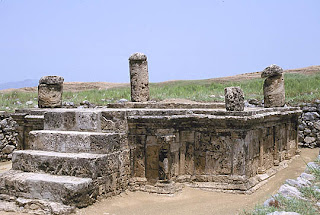Definition: The World Heritage site of Taxila is located in Punjab Province of what is now Pakistan, about 30 kilometers from Islamabad. The site includes numerous related buildings, fortifications, settlements and monasteries, and shows architectural influences for the length of its role as a Buddhist training center, between the 5th century BC through the 2nd century AD. The capital was conquered by several groups, including Alexander the Great in the 4th century BC. As a result, Persian, Greek and Asian influences are visible in the ruins of the city.
Construction of Taxila museum started in 1918, its foundation stone laid by Lord Chemsford, vicery of India in 1918. Construction was concluded in 1928 and the museum was opened for public by Sir Habibullah then the ministry for Education. Sir John Marshall who was going to be retired from the post of Director General of Archaeological survey of India in 1928, could not complete its original plan. The government of Pakistan constructed the northern gallery in 1998. There are 4000 objects displayed, including stone, stucco, terracotta, silver, gold, iron and semiprecious stones. Mainly the display consists of objects from the period 600 B.C to 500 AD. Buddhist, Hindu and Jain cults are well represented through these objects discovered from three ancient cities and more than two dozen buddhist stupas and monasteries and Greek temples. Taxila Museum is located 35 km from Islamabad on the Grand Trunk Road to Peshawar. It is famous for remains of Ganghara Art. Most of the sites at Texila, dating back 600 BCE to 500 CE, are located around the Taxila Museum.
Taxila Museum:
Taxila Museum is located at Texila, Punjab, Pakistan.Construction of Taxila museum started in 1918, its foundation stone laid by Lord Chemsford, vicery of India in 1918. Construction was concluded in 1928 and the museum was opened for public by Sir Habibullah then the ministry for Education. Sir John Marshall who was going to be retired from the post of Director General of Archaeological survey of India in 1928, could not complete its original plan. The government of Pakistan constructed the northern gallery in 1998. There are 4000 objects displayed, including stone, stucco, terracotta, silver, gold, iron and semiprecious stones. Mainly the display consists of objects from the period 600 B.C to 500 AD. Buddhist, Hindu and Jain cults are well represented through these objects discovered from three ancient cities and more than two dozen buddhist stupas and monasteries and Greek temples. Taxila Museum is located 35 km from Islamabad on the Grand Trunk Road to Peshawar. It is famous for remains of Ganghara Art. Most of the sites at Texila, dating back 600 BCE to 500 CE, are located around the Taxila Museum.
The City of Stones:
Moving northwards from Harappa and Moenjodaro, come remains of another city that thrived between 518 BC to 600 AD. Around the present day Taxila and a little over 20 miles north of Islamabad, lie the remains of the an ancient city whose actual name varies from scripture to scripture and from one language to another. "Tashasila" as it was called in Sanskrit gives some idea of the meaning of this name. Sila in Sanskrit means rock or stone . The legend says that the Buddha gave his head in charity to a man at this place . The Chinese called it "Chu-cha-shi-lo". The difficulty of Chinese phonetics with the sila and sira has led to this day to have names around Taxila such as Sirkap, Sirsukh and Margalla. Whatever its actual name. it was the most flourishing of all the cities between the Indus and Jhelum Rivers. Darius I formed it part of Achaemenid Empire of Persia. In 326 BC Alexander the Great and his armies encountered the charging elephants at battle against Hindu king Porus.
Taxila is said to be a teaching place or a modern day university, where students could study any subject, "religious or secular, from the Vedas to mathematics and medicine, even to astrology and archery". The prominence of Taxila as a seat of academic and practical teaching was a result of the city’s geographical location and its reputation as an institute that promoted exchange and discussion of both western and eastern ideas. The city abounds in Gandhara architecture and a semblance of Greek imprints. It is just a coincidence that Islamabad was designed by a Greek Architect /Town Planner called "Doxiades " who also used a lot of the Gandhara architectural style in constructing the new Institution at Islamabad notably the Islamabad University.
Bhir Mound:
Dharmarajika Stupa (2nd century AD) The earliest Buddhist monument in Pakistan:
Dharmarajika Stupa is one of eight shrines constructed in the 3rd century BC during the reign of Emperor Ashoka of the Mauryan dynasty to house relics of the Buddha. The shrine gradually expanded, reaching its largest size in the 2nd century A.D. Now a ruin, the stupa was once coated with lime plaster and gilding, though these have fallen away along with a seven-tier umbrella stone that once crowned the top. Near the stupa are the remains of vast monasteries that are barely distinguishable but for the foundation stones.
Just a few dozen meters from the Shrine of the Double-Headed Eagle sits the Jain Stupa, a relic of the Sirkap city period. The shrine is badly ruined. Nothing of the superstructure survives. The persepolitan columns with lion ornamentation that sit on the four corners were brought here from the ruins of the courtyard.
Jain Shrine along the streets of Sirkap (2nd century BC to 2nd century AD)
Other Pictures:































